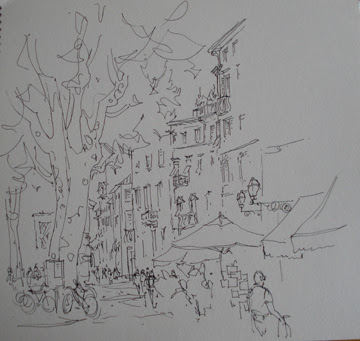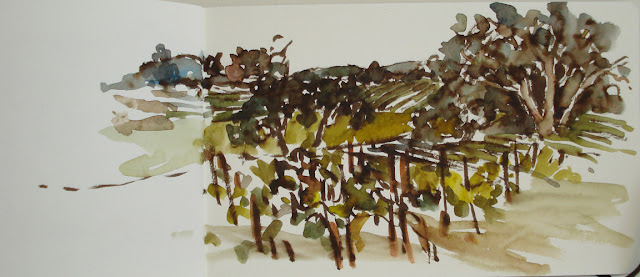Good Advice
 |
| Line Drawing, Lucca |

 |
| Line Drawing, Lucca |
Watercolor Musings: A No-Excuses Travel Kit: “Materials with the first drawing of an oak tree outside Tablas Creek Winery This last weekend we were in the Central Coast with a group …”
 |
| Materials with the first drawing of an oak tree outside Tablas Creek Winery |
This last weekend we were in the Central Coast with a group of University of Redlands Alumni on a wine-tasting adventure. I put this small kit together that would easily fit in my purse to have “just in case.” I have been in too many places without materials and either waste time finding something to use or been frustrated. I included a “palette” of 6 colors (2 yellows, 2 reds and 2 blues) in a pastilles box. Empty pans are available at many art stores and online. Any metal box such as altoids work well. A white lid would be preferable since it would show the color better than this metallic one…but I had this one already. I also included a Niji waterbrush and a pentel ink brush with water soluble sepia ink. The Moleskin watercolor sketch book is 5″x8″ and makes a nice wide panorama when opened. The book has an elastic band which holds it tightly closed. That’s all I used for this work.
My chance to draw came with an “oops” on the bus drivers part…he took a corner a bit too close and got hung up. We later found out that buses do this routinely. When it looked as if we’d be there awhile, I got my kit out and drew the oak tree. As time progressed I began another drawing and had time to add color.
 |
| Tablas Creek #2 |
We stopped for lunch at Denner’s Winery and I had just a small amount of time before we were off again. In this drawing you can see the advantage to the ink line. I only had time to add color to the central part of the drawing but I like the way the lines extend that. I later found out that my nephew’s young vineyard is in the distance. I visited with my sister before we came home and hadn’t realized the proximity when I drew this.
 |
| From the patio at Denner Winery |
At the last winery, I let everyone else go taste and I just drew. Vines are in the foreground and the oaks with their dark foliage are a wonderful contrast to the warm tones of the vines and golden hills.
 |
| Last winery stop |
Each of these drawings is as I left them at the time of drawing. The second image took about 30-40 minutes and the final two under 30 minutes.
Having a small, portable watercolor or drawing kit is a real advantage. I hadn’t expected to have time to do anything, but have learned the hard way to be prepared.
Watercolor Musings: Provencal Pumpkins – Mixed Media Stained Collage: “I love working with a combination of materials. Stained paper collage is an exciting way to work in the studio. Watercolor-stained rice pa…”
 |
| I love working with a combination of materials. Stained paper collage is an exciting way to work in the studio. Watercolor-stained rice paper is affixed to a sturdy ground (I use 300# watercolor paper) with matte medium or a mixture of white glue and water. The whole surface is covered with the rice paper. Some of the drawing shows through but you can’t count on that. Too much medium or glue will make it difficult to paint watercolor on top. |
 |
||||||
| After the first step is thoroughly dry, the painting is finished with both watercolor and white gouache. The final version is pulled together by the painting process and is enhanced by the wonderful colors and texture provided by the collage beneath. In this one, I was slightly worried that I’d made a hash of the first step. It was so “clunky” compared to what I had in mind. |
Watercolor Musings: Paper Makes a BIG Difference: “Provencial Pumpkins on Yupo by Judy Schroeder Two paintings of the same subject, painted on paper with watercolor yielded completely diff…”
Watercolor Musings: Crystal Cove and the Benefits of Working on Locat…: “Usually I try to get several reference photos when painting on location. Once I’ve visited and painted a place, I feel comfortable p…”
Watercolor Musings: Everything But the Kitchen Sink: “Whenever I’m off on a painting trip, I gather books, pamphlets, newspapers, tickets, etc. Mostly, these questionable ‘treasures’ stay in a f…”
Watercolor Musings: Sketching En Route: “Finding time to do the things we really want to do, rather than squishing them in when time allows, takes some creativity and planning. If y…”
Watercolor Musings: Adding Ink to Watercolor: “I have been doing a version of ink and watercolor at least since high school. In 2001, I began to use it more frequently and made a habit of…”
The University of Redlands, my alma mater, celebrated it’s centennial in 2006-2007. Because of that, there was a float in Pasadena’s New Year’s Parade on January 1, 2007. After being introduced to the delight of painting in the float barns by my painting buddy, Brenda Swenson, I secured permission for us to visit the Redlands float as it was being readied for the parade.
We had to be creative since the floats were overhung with scaffolding, crawling with petal-pushers and without much of the planned flora. Adding to that was the necessity of our taking as little space as possible so we would be out of the way of the workers.
We took in our sketchbooks, a small watercolor palette and waterbrushes. These brushes are filled with water and when you change color, you squeeze out some water to cleanse the bristles. The two drawings here were done in that way. The colors are amazingly clear and un-muddied. The brushes are available at most art supply stores and on-line suppliers – my favorite are those made by Niji.
Watercolor Musings: Waterbrushes on location: “The University of Redlands, my alma mater, celebrated it’s centennial in 2006-2007. Because of that, there was a float in Pasadena’s New Yea…”
Whenever I’m off on a painting trip, I gather books, pamphlets, newspapers, tickets, etc. Mostly, these questionable “treasures” stay in a folder. With this technique, however, all those bits and oddments have a purpose and a place to be.
The surface is drawn upon, collaged with various papers, painted with watercolors, gessoed, re-drawn upon, re-collaged with papers relating to the subject, painted with gouache and again with watercolors, over and over again until the image is pleasing to the artist.
The upper image is of Bibury, Cotswolds, England. It was the home of wool weavers long ago and is rumored to be the most photographed spot in England. I love the way the houses hug the hill, each reflecting the lovely golden Cotswold stone. The lower 2/3rds is composed of all the aforementioned gatherings from my trip. There are doilies, photographs, words from newspapers, written words and fascinating words from signage.
I have been doing a version of ink and watercolor at least since high school. In 2001, I began to use it more frequently and made a habit of taking small handmade watercolor paper with me on travel workshops using a roller ball pen with water-soluble ink. I liked the way the ink moved and ran as I worked, creating passages within the piece. That led to a chapter in “Work Small, Learn Big,” a book on sketching in pen and watercolor published by International Artist Magazine in 2003.
Subsequently, I wanted to work in a larger format, but the small pens were not appropriate for that. I finally found a watersoluble ink brush with a cartridge in the Daniel Smith catalog…a brush pen used for sumei. It took awhile to get the courage to spend over $60 for the Kaimei brush pen, but when I did and used it for the first time, I was hooked. Finding the brush pens is now easy…D. Smith still carries them and typing “oriental brush pen” in a search engine leads to many more sources.
Recently I found a brush pen with sepia ink and I like the warmer tones of the brown ink. Here is one of the most recent, a painting of the southwest quadrant in Old Towne Orange’s Plaza Square. In this case the under-painting in blue was done before I went out to paint. I find that I like the results better if the under-painting is done with no thought of the subject matter to be superimposed on top. When I begin to draw, I watch the placement of the shapes to make best use of the lighter areas and draw directly in ink. My brush pen basically goes for a dance across the page and my drawings are more fluid with this technique. Watercolor is applied when the line drawing is complete and if done immediately the ink blends with the watercolor. If you wait a number of days, the ink is set and washes can be applied across the line with no bleeding. You lose the variation in edge quality however.
The addition of ink to watercolor is especially helpful when working in a sketch book with limited time. If you have a good line drawing, you can add minimal watercolor paint to have a good representation of the scene. And by holding back a bit on the brush pen, the line can be less powerful in a smaller format.
Watercolor Musings: Sketching En Route: “Finding time to do the things we really want to do, rather than squishing them in when time allows, takes some creativity and planning. If y…”